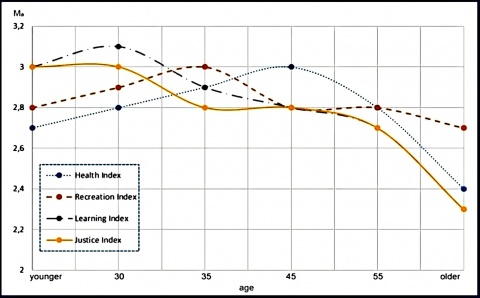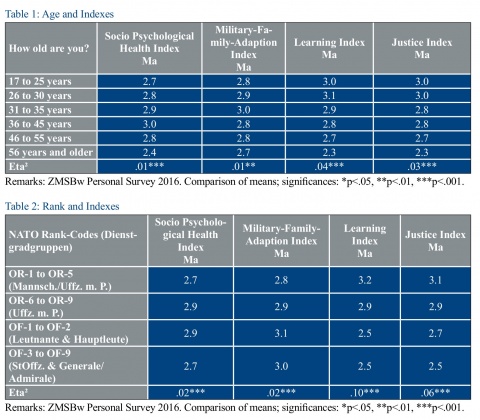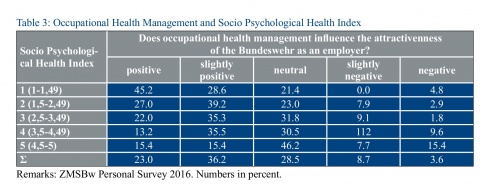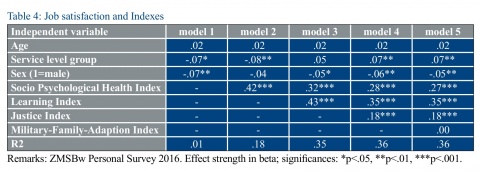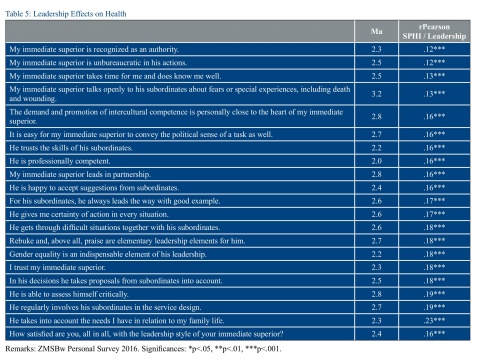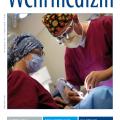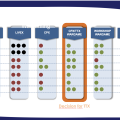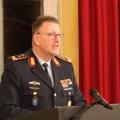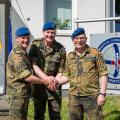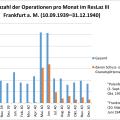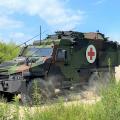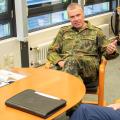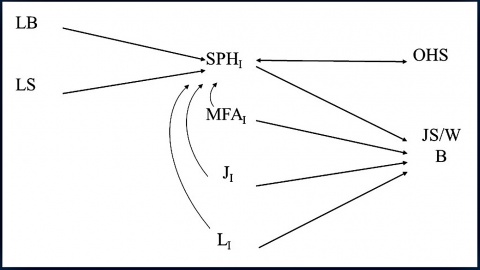
Consequences of Leadership Behavior for Job Satisfaction and Health in the Bundeswehr
From the Bundeswehr Center for Military History and Social Sciences, Potsdam (Commanding Officer: Captain (Navy) Dr. J. Hillmann)
Martin Elbe
Summary
Leadership behavior is stated to have a core influence on wellness and the experience of health that members of organizations in general have – it is to be expected that this is to be found in military organizations too. In 2016 a research project on the attractiveness of the Bundeswehr as an employer with a special focus on job satisfaction (which is to be interpreted as well-being) as well as aspects of health and leadership has been conducted by the Bundeswehr Center for Military History and Social Sciences (ZMSBw). The data was statistically analyzed with SPSS. On this empirical basis the paper discusses the different aspects of well-being as well as on phy-sical and psychological health aspects. Especially target-performance comparison of leadership dimensions will be focused on in their impact on health. The influence of socio psychological aspects like justice and learning and of occupational health management on health and well-being is analysed and the relevance of physical and psychological health aspects is discussed.
Keywords: Leadership, job satisfaction, health, well-being, social psychology
Zusammenfassung
Führungsverhalten ist ein wichtiger Einflussfaktor für das Wohlbefinden und das Gesundheitserleben von Organisationsmitgliedern im Allgemeinen, und es ist zu erwarten, dass dies auch in militärischen Organisationen gilt. Im Jahr 2016 wurde ein Forschungsprojekt zur Attraktivität der Bundeswehr als Arbeitgeber mit besonderem Fokus auf die Arbeitszufriedenheit (die hier als Wohlbefinden interpretiert werden soll) sowie auf Aspekte von Gesundheit und Führung am Zentrum für Militärgeschichte und Sozialwissenschaften der Bundeswehr (ZMSBw) durchgeführt. Die Daten wurden statistisch mit SPSS analysiert. Auf dieser empirischen Basis werden die verschiedenen Aspekte des Wohlbefindens sowie körperlicher und psychischer Gesundheit diskutiert. Vor allem die zielgerichtete Wirkung von Führungsdimensionen aus gesundheitlicher Sicht steht hierbei im Fokus. Der Einfluss von sozio-psychologischen Aspekten wie Gerechtigkeit und Lernen sowie des betrieblichen Gesundheitsmanagements auf Gesundheit und Wohlbefinden wird analysiert und die Relevanz unterschiedlicher körperlicher und psychischer Gesundheitsaspekten diskutiert.
Schlüsselworte: Führung, Arbeitszufriedenheit, Gesundheit, Wohlbefinden, Sozialpsychologie
1.0 Introduction
Total health, well-being and wellness have become an important aspect in military life and for the functionality of military organizations. Leadership behavior is stated to have a core influence on the experience of health members of organizations in general have. In military organizations this is of even greater importance as the interrelation of leadership and health influences the soldiers’ performance directly and in combat leadership is responsible for the soldiers’ survival. Action forces can be described as organizations where cold phases of operation „... where there is no need for real action ...“ [25, p. 247] are followed by hot phases of action. Although deployment is more and more common for the armed forces in most countries, soldiers spend most of their time in cold phase situations with everyday life working conditions. Even though sports and physical fitness are important elements of military training and canteen food supports a healthy diet, general working conditions, leadership and social stability seem to have a crucial impact on the soldiers’ health condition and job satisfaction.
This paper discusses the different aspects of leadership behavior in its influence on job satisfaction as well as on health aspects. Especially target-performance comparison of leadership dimensions will be focused on in their impact on health. The influence of socio psychological aspects like justice and learning and of occupational health management on health and well-being will be discussed. After a look at the theoretical background three questions will be discussed:
1. What influences soldiers’ health in the Bundeswehr?
2. What influences soldiers’ well-being in the Bundeswehr?
3. What effect does leadership have on health for soldiers in the Bundeswehr?
The findings will be finally discussed in a résumé.
2.0 Theoretical Background
First of all, leadership and health are problems of everyday life in the military. Soldiers interact with their superiors and this interaction is thought to have an impact on health and well-being of the subordinates as well as the superiors. In the Bundeswehr (as supposed in most armed forces) there are regulations dealing with leadership and with health in the military. In the Bundeswehr soldiers are obliged by the military service act to keep up their health (Soldatengesetz, § 17 (4)). They must not intentionally or grossly negligently affect their health. The soldier must tolerate medical intervention with regard to his physical integrity to a certain extent. The Bundeswehr Central Regulation A-2600/1 on Civic Education and Leadership (Innere Führung) points out the connection between health and leadership: „Superiors make an important contribution to maintaining the health of their soldiers.” [5, p. 28] This interrelation between leadership and health is quite obvious and applies not only to the military, but as F. W. Taylor put it: “The elimination of ‘soldiering’ and of the several causes of slow working … would have a more permanent and far-reaching effect upon these misfortunes than any of the curative remedies that are now being used to soften their consequences.”[26, p. 15] Taylor used ‘soldiering’ according to the habit of the time as an expression for slow working and to him it was quite clear, that management and leadership were main influences on the health and efficiency of workers. So, health and work have been a topic for the academic since the early 20th century. Since the 1990ies interest in occupational health issues, absentism and job satisfaction has increased significantly [16]. According to Vincent [27] there is a broad empirical basis by now as well as theoretical analysis of the connection between leadership behavior and health or well-being in occupational contexts. Badura’s anthology [3] provides an overview of the state of research and the rapidly differentiating breadth of empirical instruments and investigations. At the heart of the consideration is the health of the employees and the effect of the management behavior of superiors on this, as well as the health of the executives themselves. Gregersen/Kuhnert/Zimber/Nienhaus [10] examine the influence of leadership on employee health using a meta-analysis in which they evaluate 42 studies between 1990 and 2009. They conclude that leadership can function both as a resource and as a stressor. In addition to leadership, other factors (e.g. personality of the employees, working conditions) influence health. In addition to stress, job satisfaction is raised as the most common feature in the investigations and is considered a health indicator in this study. Leadership is an important factor for corporate health experience and combined with self-management [21]. Stress obviously is one of the key factors influencing health and self-efficacy is an important resource for healthy behavior under working conditions. As Hüttermann [13] shows, there is a link between leadership and mental health, but he sees the need for further studies and, in particular, on the effect on intermediate superiors.
Kastner [14, 15] places leadership and health in the context of holistic, inclusive, sustainable and system-oriented performance and health management. He notes that there are links between organizational culture, leadership, performance and health that cannot be squeezed into simple schemes. In order to promote a culture that is beneficial to health, it is necessary to integrate work design and good leadership in such a way that performance and health are addressed in equal measure. This is done in particular through the imparting of recognition and appreciation. For several years, Westermayer has been pointing out in his long-term study on the link between work and health (with approximately 25,000 respondents) that next to leadership learning is one of the key influencing factors for health [28]. In their anthology Zinner/Elbe/Lange [30] develop health coaching as a specific approach to health promotion under working conditions. Based on central problems in the field of management and health such as organizational culture and socialization, the relevant systems and actors are identified and, building on them, practical design, development and competence perspectives for coaching as a leadership task are presented. As McMahon/Williams/Tapsell [20] show, there is a broad discussion throughout the disciplines whether wellness or well-being would be an appropriate concept to get an expanded perspective on health. Health – in contrary to sickness as a medical condition – is not yet sufficiently defined [9] but, in a basic sense, may be referred to as the experience of being physically and mentally in an appropriately good condition. Well-being covers a broader perspective than health, it refers to a sense of coherence [1], a state of satisfaction with the overall situation whereas wellness seems to refer to a state of contentment with a rather temporary covering. In connection with occupational health issues it is not so much the short term concept of wellness that is sought, but a longer-term sense of coherence, which, from a labour science point of view, can be found in job satisfaction.
In the military there seems to be an important influence by the intersection of two societal institutions: family and the military, both of which make great demands on the soldiers [[24]. Burrell et al [6] showed the influence of family military adjustment has on psychological and physical well-being. There is also a connection of recreation as a ressource for coping with stress to be seen.
Considering these insights it is to be expected, that in military settings leadership and job satisfaction would also have a large influence on the experienced health state of the soldiers. Klamar et al [17] analysed how leadership and commitment influenced soldiers’ health experience in the Bundeswehr with N=1,294 participants. Their finding is that there is a relation between commitment, health oriented leadership and the employees’ health, although there is an especially strong effect of health oriented leadership on participants with a low commitment. Hoffmann [12] compares the influences of health on work in the military and in privat companies and Lusch [19] discusses leadership in the area of tension between goal attainment and health management (with a special focus on sports). Especially in the military there seems to be a strong link between health and leadership.
3.0 Empirical Reasearch & Measures
In 2016 a research project on the attractiveness of the Bundeswehr as an employer with a special focus on job satisfaction as well as aspects of health and leadership has been conducted by the Bundeswehr Center for Military History and Social Sciences (ZMSBw). 3,197 questionaires (33 %) were returned by soldiers and civil employees of the Bundeswehr. The data was statistically analysed with SPSS [23]. In this personnel survey the attractiveness of the Bundeswehr as an employer was the main topic, combined with soldiers’ needs, job satisfaction and leadership aspects. It was a paper and pencil survey with a field phase of five weeks in June/July 2016. For the paper presented only those participants that clearly stated to be soldiers were taken into account (N=2,121) and the focus is not on the attractiveness of the Bundeswehr as an employer but on how the aspects health and well-being interact with leadership. To answer the three questions raised in the introduction eight key variables will be used in the analysis. In the centre of the explanatory model four variables have been constructed as indexes. In the questionnaire there are 32 items with needs that possibly should be fulfilled (range from one to five). This scale has been used for several years by the ZMSBw to analyse the soldiers’ and civil servants’ needs and motivation [23] and goes back to a specification of Alderfer’s ERG-Theory from 1972 [2]. In this analysis of motivational effects health and wellness aspects as well as job satisfaction haven’t been focused on so far. This will be conducted here. From the 32 motivational items four indexes with four items each have been extracted to measure health and well-being effects:1. Socio Psychological Health Index (SPHI)
The Socio Psychological Health Index consists of four items. Two items represent how much the Bundeswehr cares about soldiers’ health (Are there healthy working conditions? And Does the Bundeswehr offer extensive social benefits, such as free medical care?). The other two items represent hygiene factors in the sense of Herzberg [11]: salery (Are you well paid?) and personal life (Is it possible for you to reconcile family and service well?). These aspects are considered to influence soldiers’ health conditions directly.
2. Military-Family-Adaption Index (MFAI)
The Military-Family-Adaption Index includes the items “You rarely have to move because of your job.”, “You don’t have to work more than 41 hours a week.”, “You always have off on weekends.” and “You rarely have to do business trips.” These aspects influence recreation as a resource for coping with stress and are to be considered as general factors on psychological and physical well-being.
3. Justice Index (JI)
The justice index contains the items “Men and women are treated equally.”, “There are clear responsibilities in an obvious hierarchy.”, “There is comradeship and teamwork.” and “I can have a say in important issues.” Social justice is considered to have a strong influence on peoples’ well-being.
4. Learning Index (LI)
The learning index includes the items “I can unfold and develop.”, “I can regularly take on new tasks.”, “I can often learn new things.” and “I can foster my training and education on a regular basis.” Learning is a key aspect of personal growth and well-being.
In the ZMSBw-survey of 2016 job satisfaction (well-being) was measured with the question “How satisfied are you at present, all in all, with your service in the Bundeswehr?” (JS/WB). According to the theoretical and empirical background leader-ship and job satisfaction (which is to be interpreted as well-being) is a broader construct than health. The influence factors on well-being are expected to be found in the indexes and are analysed in this paper.
The interrelation between leadership and health is of great importance for all military settings and an important aspect for the concept of Innere Führung [5]. Dörfler-Dierken/Kramer [7] have translated the central requirements for leadership from the Bundeswehr Central Regulation A-2600/1 on Civic Education and Leadership (Innere Führung) into a scale with 20 items to measure leadership behavior (LB), comparable to LBDQ – Leader Behavior Description Questionaire or FVVB – Fragebogen zur Vorgesetzten-Verhaltens-Beschreibung [22]. This concept was used for measuring leadership in this study, added by a principal question on leadership satisfaction (LS): “How satisfied are you, all in all, with the leadership style of your immediate superior?” Leadership will be differentiated into factors and their impact on health will be focused on as well as other socially relevant constructs such as justice, security and learning.
The influence of Occupational Health Management (OHM) was measured by asking, whether it influences the attractiveness of the Bundeswehr as an employer and whether the participants already had had any experiences with Occupational Health Management.
Figure 1 shows the expected influences between the eight variables in the explanatory model. It is expected that health interrelates with the other three indexes and occupational health management. An influence of all four indexes on well-being (job satisfaction) is expected as well as an influence of leadership behavior and leadership satisfaction on health.
The first question, on what influences health for soldiers in the Bundeswehr, is approached in section 4.1 with the examination of the interrelation between the indexes, age, service grade and occupational health management. The second question, on what influences well-being for soldiers in the Bundeswehr, is examined in section 4.2. The third question, on what effect does leadership have on health for soldiers in the Bundeswehr, and the final inquiry on the interrelations of the indexes are dealt with in section 4.3 to finally be able to answer all three question.
4.0 Findings
4.1 Health, Well-Being & Occupational Health Management
The four indexes with four items each show acceptable interrelatedness (Cronbach’s α) and show means (Ma[1]) with a slightly positive tendency:
- The Socio Psychological Health Index (N = 2,085) shows a Cronbach’s α = .63, a mean Ma = 2.81 and standard deviation SD = .80.
- The Military-Family-Adaption Index (N = 2,015) has a Cronbach’s α = .68, a mean Ma = 2.9 and standard deviation SD = .85.
- The Justice Index (N = 2,071) shows a Cronbach’s α = .62, a mean Ma = 2.9 and standard deviation SD = .99.
- The Learning Index (N = 2,111) shows a Cronbach’s α = .84, a mean Ma = 2.9 and standard deviation SD = .82.
- The highest score is to be found in the Socio Psychological Health Index (Ma = 2.5), which shows that soldiers generally experience good health conditions, with the highest value of Ma = 1.8 in social benefits (esp. free medical aid). The Socio Psychological Health Index is the key objective of this analysis, the other three indexes (recreation, justice and learning) are constructed as expressions of well-being.
Recreation, learning and justice are all significantly influenced by the service groups (Eta²). Active soldiers assess health and recreation as related constructions as well as learning and justice, which is also shown by a correlation analysis: rPearson is significant between all four indexes but only the combinations of Socio Psychological Health Index and Military-Family-Adaption Index have high scores (rPearson = .51***) on the one side and Learning Index and Justice Index on the other hand (rPearson = .47***). Well-being is influenced by more factors with structural and personal aspects being involved. From a structural perspective the Bundeswehr “Agenda for Attractivity” especially fosters occupational health management as one of eight areas of measures. As 9.8 % of the soldieres state to have personally participated in the program and 32.2 % have experienced effects in their direct work environment, 57.9 %have not seen any effect so far. Still 59.3 %think that occupational health management has a positive impact on the attractiveness of the Bundeswehr as an employer and there is a significant correlation between the assessment of occupational health management and the Socio Psychological Health Index (rPearson = .17***). Table 3 shows the data and Figure 3 shows the interrelation between the two variables.
Occupational Health Management and programs of occupational health promotion are important for the majority of the soldiers in the Bundeswehr and it is quite clear, that those soldiers with a high Socio Psychological Health Index consider occupational health management as most important. The problem is that only 10.1 % of the soldiers so far have directly participated in an occupational health activity, 32.5 % have noticed it in their direct working surrounding and 57.4 % have no experience at all with it. Again: Those soldiers with more experience assess occupa-tio-nal health management more positively than those without any know-how.4.2 Influences on Well-Being
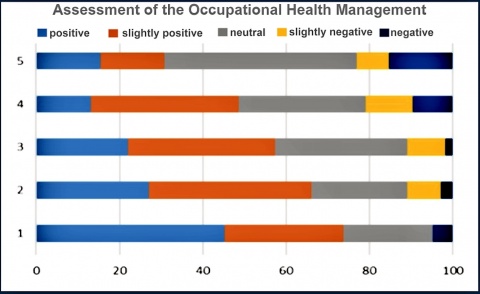
The dependent variable in all models is job satisfaction.
- Model 1 shows the influence of general social determinants (age, status measured as service level group and sex) on job satisfaction. Although all influences are weak, sex and status seem to have an impact on such a low level (R² = .01) that it has to be assumed, that they might be hygiene-factors more than motivators [11].
- Model 2 takes the Socio Psychological Health Index into account – the impact of health on job satisfaction is highly significant and rather intense (Beta = .42***) – 18 % of the variances can be explained.
- If the Learning Index is introduced (Model 3) the explanatory strength rises to R² = .35 (35 % of the variances can be explained). Both indexes (health and learning) have significant influence, although the effect strength of the health index declines to Beta = .32*** and the Learning Index becomes the strongest influence with Beta = .43***.
- In Model 4 the Justice Index is introduced and again there is a significant influence of Beta = .18***, but learning remains the strongest influence (Beta = .35***) and health the second strongest (Beta = .28***).
- Introducing the Military-Family-Adaption Index (Model 5) doesn’t change the constellation any more. Military-Family-Adaption doesn’t have an influence on job satisfaction itself, the explanatory strength doesn’t change and the influence effects are stable: Learning has the strongest impact, the influence of health is second in intensity and justice third.
4.3 Leadership & More Influences on Health
As mentioned before the interrelation between leadership and health is of great importance for all military settings. As men--tioned before the central requirements for leadership from the Bundeswehr Central Regulation A-2600/1 on Civic Education and Leadership (Innere Führung) [5] have been translated into a scale with 20 items to measure leadership behavior. Table 6 shows all 20 items measuring the importance of leadership aspects as well as raising an item to describe the overall satisfaction with the immediate superior. Table 6 shows the means for all items and in the last column the rPearson-correlation between the Socio Psychological Health Index and the leadership items (this is what the table was sorted for). Table Ma gives the mean of all items, for the whole scale Ma = 2.5. The average of the scale is a little lower than the mean of the overall satisfaction with the immediate superior (Ma = 2.4).
All items in the scale as well as the satisfaction item show significant correlations, the following items have an especially high impact:
- Family life: He takes into account the needs I have in relation to my family life.
- Embedding: He regularly involves his subordinates in the service design.
- Self-Criticism: He is able to assess himself critically.
- Participation: In his decisions he takes proposals from subordinates into account.
- Trust: I trust my immediate superior.
- Gender Equality: Gender equality is an indispensable element of his leadership.
- Appraisal: Rebuke and, above all, praise are crucial leadership elements for him.
- Attendence: He manages difficult situations together with his subordinates.
- Certainty: He gives me certainty of action in every situation.
- Example: For his subordinates, he always leads the way with good example.
In direct relation leadership seems to have a significant influence on health in the Bundeswehr as a work environment but to answer the last of the three questions raised in the introduction to this paper, on what effect leadership has on health for soldiers in the Bundeswehr, leadership and health have to be analysed in a more complex model. Table 6 shows five models of linear regressions with an increasing number of independent variables that might influence health as a dependent variable.
The dependent variable in all models is the Socio Psychological Health Index. Model 1 again shows the influence of general social determinants (age, status measured as service level group and sex) on health. Again all influences are weak, with only sex having a significant influence but with litte effect (R² = .01). Model 2 takes the Military-Family-Adaption Index into account and here we see a highly significant and strong effect (Beta = .53***) – already 28 % of the variances can be explained. In this model all general social determinants have significant effects. The Introduction of the Learning Index (Model 3), the Justice Index (Model 4) and finally the overall-satisfaction-leader-ship-item in Model 5 only contribute another .05 to the explanatory strength of the model (R² = .33). In Model 5 the Military-Family-Adaption Index still has the greatest influence (Beta = .48***), the Justice Index is the second strongest (Beta = .18***), age has a positive effect (Beta = .09***), women feel less healthy (sex: Beta = -.08***). Learning (Beta = .06*) and Leadership (Beta = .07**) both have less influence on lower significance levels.
Although recreation is a hygiene-factor and not a motivator for work-related well-being it has the most important influence on health. Health being a more narrow construct than well-being is directly related with recreation as the strongest influence and with the experience of justice. Satisfaction with leadership has an influence on health but in comparison with the two strong influencers (recreation and justice), it is one of the slight influencers (together with age, sex and learning). It is an interesting effect with leadership studies: The comparatively strong effects leadership seems to have[2], when the direct effect on a dependent variable is measured seems to fade when the models become more complex.5.0 Résumé
The first question was “What influences soldiers’ health in the Bundeswehr?” As shown in section 4.1 age and rank/service group level influence the experience of health, there is a slight bulge in the mid 40ies and for the middle ranks (OR-6 to OF-2), these soldiers feel less healthy than those younger and with lower ranks or older and with higher ranks. For military family adaption the bulge is approximately ten years earlier (in the mid 30ies). Learning and justice show different effects throughout ages or ranks, with a tendency toward the older soldiers are and the higher their rank is the better learning and justice are realized. As can be seen in table 6 military family adaption has a strong direct influence on health, followed by the feeling for justice. Age, sex and learning have a significant influence but on a much lower level. The influence of the service group level in a complex model is not significant. 42 % of the soldiers have direct or indirect experience with occupational health management – those soldiers with more experience assess occupational health management more positively. The problem is: 52 % haven’t had any experience with occupational health management in 2016.
The second question, on what influences soldiers’ well-being in the Bundeswehr, has been examined in section 4.2. Well-being was introduced as a broader concept than health and refers to a state of satisfaction with the overall situation. In this survey it was measured as overall job satisfaction. As shown in Table 3 well-being in working environments is most intensely influenced by the ability to learn and develop, followed by health and justice but military family adaption doesn’t have a direct influence. These findings support the two-factor theory [11] and confirms the importance of learning in working conditions for well-being [28]. This is an influence on the broader concept of well-being, not so much directly on health (Table 6).
The third question, on what effect leadership has on soldiers’ health in the Bundeswehr, can be answered with the insight, that all leadership aspects measured directly had a significant influence on health, although the effect strength was not very high. Also in a more complex explanatory model satisfaction with leadership does have a direct influence on health – but in comparison with military family adaption and justice, it is a rather week influence, just like age, sex and learning. Leadership seems to be a fluid institution – it is consumed by other aspects in more complex models. One might say: It is maybe not organizational culture only that eats leadership for breakfast[3], but complexity in general. At least that is what can be stated in conjunction with health in the military.
6.0 References
- Antonovsky, Aaron (1987): Unravelling the Mystery of Health. San Francisco: Jossey-Bass.
- Alderfer, Clayton (1972): Existence, Relatedness, and Growth. Human Needs in Organizational Settings. New York: Free Press.
- Badura, Bernhard/Ducki, Antje/Schröder, Helmut/Klose, Joachim/Macco, Katrin (2011) (ed.): Fehlzeitenre-port 2011: Zahlen, Daten, Analysen aus allen Branchen der Wirtschaft. Schwerpunkt: Füh-rung und Gesundheit. Berlin: Springer.
- Banchflower, David/Oswald, Andrew (2008): Is well-being U-shaped over the life cycle? In: Social Science & Medicine, 66 (8), pp. 1733-1749.
- BMVg (2008): ZDv A-2600/1 – Innere Führung. Selbstverständnis und Führungskultur. Berlin: BMVg.
- Burrell, Lolita/Adams, Gary/Durand, Doris/Castro, Carl (2006): The Impact of Military Lifestyle Demands on Well-Being, Army, and Family Outcomes. In: Armed Forces & Society, 33 (1), pp. 43-58.
- Dörfler-Dierken, Angelika/Kramer, Robert (2014): Innere Führung in Zahlen: Streitkräftebefragung 2013. Ohne Ort: Miles.
- Elbe, Martin (2016): Sozialpsychologie der Organisation: Verhalten und Intervention in sozialen Systemen. Berlin: Springer Gabler.
- Elbe, Martin (2019): Grundkonzepte soldatischer Gesundheit. In: Elbe, Martin (ed.): Die Gesundheit des Militärs. Vol. 52 in the series Militär und Sozialwissenschaften publ. by AMS. Baden-Baden: Nomos. [forthcoming]
- Gregersen Sabine/Kuhnert Saskia/Zimber Andreas/Nienhaus, Albert (2011): Führungsverhalten und Gesundheit – Zum Stand der Forschung. In: Das Gesundheitswesen 73 (1), pp. 3-12.
- Herzberg, Frederick (1987): One More Time, How Do You Motivate Employees? Harvard Business Review. September-October 1987. Reprint Nr. 87507. URL 04.03.2019: https://www.thealexandergroup.com/static/uploads/photos/2012-04/HBR_One_More_Time.pdf.
- Hoffmann, Erwin (2019): Vergleich der Führungspraxis und Gesundheit in der Wirtschaft und in den Streitkräften. In: Elbe, Martin (ed.): Die Gesundheit des Militärs. Vol. 52 in the series Militär und Sozialwissenschaften publ. by AMS. Baden-Baden: Nomos. [forthcoming]
- Hüttermann, Hendrik (2015): Der Einfluss von Führung auf psychische Gesundheit: Ein Blick in die Forschung. In: Becker, Peter (ed.): Executive Health – Gesundheit als Führungsaufgabe. Wiesbaden: Springer Gabler, p. 13-29.
- Kastner, M. (2017): Zusammenhänge zwischen Organisationskultur, Führung, Leistung und Gesundheit. In: Stierle Jürgen/Wehe Dieter/Siller Helmut (ed.): Handbuch Polizeimanagement. Wiesbaden: Springer Gabler, p. 507-534.
- Kastner, Michael (2010): Führung und Gesundheit im Kontext eines ganzheitlichen, integrativen, nachhaltigen und systemverträglichen Leistungs- und Gesundheitsmanagements. In: Kastner, Michael (ed.): Leistungs- und Gesundheitsmanagement – psychische Belastung und Altern, inhaltliche und ökonomische Evaluation. Lengerich: Pabst, p. 82-134.
- Kastner, Michael (1994) (ed.): Personalpflege. Der gesunde Mitarbeiter in einer gesunden Organisation. Berlin: Quintessenz.
- Klamar, Alexander/Felfe, Jörg/Krick, Annika/Röttger, Stefan, Renner, Karl-Heinz/Stein, Michael (2018): Die Bedeutung von gesundheitsförderlicher Führung und Commitment für die Mitarbeitergesundheit (Significance of health-oriented leadership and commitment for employees health). In: Wehrmedizinische Monatsschrift: Fachorgan des Sanitätsdienstes der Bundeswehr. 62 (8), pp. 260-265.
- Libicky-Mayerhofer, Bettina (2018): Gesund führen: Angewandte Psychologie für Führungskräfte und BeraterInnen. 2. Aufl. Freiburg: Haufe.
- Lusch, Christian (2019): Führung im Spannungsfeld zwischen Auftragserfüllung und Gesundheitsmanagement in Einsatzorganisationen – Handlungsansätze aus dem Bereich des Sports. In: Elbe, Martin (ed.): Die Gesundheit des Militärs. Vol. 52 in the series Militär und Sozialwissenschaften publ. by AMS. Baden-Baden: Nomos. [forthcoming]
- McMahon, Anne/Williams, Peter/Tapsell, Linda C. (2010): Reviewing the meanings of wellness and well-being and their implications for foodchoice. In: Perspectives in Public Health, 130 (6), pp- 282-286.
- Meyer, Annedore/Töpsch, Karin/Schiller, Christina (2017): Gesund und motivierend führen. Wie Führungskräfte ihr Team und sich selbst stärken. Hamburg: BGW.
- Neuberger, Oswald (2002): Führen und führen lassen. 6. Aufl. Stuttgart: Lucius & Lucius.
- Richter, Gregor (2016): Wie attraktiv ist die Bundeswehr als Arbeitgeber? Ergebnisse der Personalbefragung 2016. Forschungsbericht 113. Potsdam: ZMSBw. URL 27.02.2019: http://www.zmsbw.de/html/publikationen/sozialwissenschaften/forschungsbberichte.
- Segal, Mady (1986): The Military and the Family as Greedy Insti-tutions. In: Armed Forces & Society 13 (1), pp. 9-38.
- Soeters, Joseph L./Winslow, Donna J./Weibull, Alise (2003): Military Culture. In: Caforio, Giuseppe (ed.): Handbook of the Sociology of the Military. New York et al.: Kluwer Academic/- Ple-num Publishers, pp. 237-254.
- Taylor, Frederick W. (1911): The Principles of Scientific Management. New York: Harper Bros.
- Vincent, Sylvie (2011): Gesundheits- und entwicklungsförderliches Führungsverhalten: Ein Analyseinstrument. In: Badura, Bernhard/Ducki, Antje/Schröder, Helmut/Klose, Joachim/Macco, Katrin (ed.): Fehlzeitenreport 2011: Zahlen, Daten, Analysen aus allen Branchen der Wirtschaft. Schwerpunkt: Füh-rung und Gesundheit. Berlin: Springer, pp. 49-60.
- Westermayer, Gerhard/Brand, Desirée (2017): Von der Fehlzeitenanalyse zur Förderung der Arbeitsfreude. In: Richter, Götz/Hecker, Christoph/Hinz, Andreas (ed.): Produktionsarbeit in Deutschland mit alternden Belegschaften. Berlin: Erich Schmidt, S. 263-273.
- Wunder, Christoph/Wiencierz, Andrea/Schwarze, Johannes/Kuechenhoff, Helmut/Kleyer, Sara/Bleninger, Philipp (2009): Well-Being over the Life Span: Semiparametric Evidence from British and German Longitudinal Data. SOEP paper No. 179; DIW Berlin Discussion Paper No. 889. URL 01.03.2019 http://dx.doi.org/10.2139/ssrn.1403203.
- Zinner, Jochen/Elbe, Martin/Lange, Daniel (2014) (ed.): Handbuch Gesundheitscoaching. Kompendium für Praxis und Lehre. Berlin: H:G.
Prof. Dr. Martin Elbe
Zentrum für Militärgeschichte und Sozialwissenschaften der Bundeswehr (ZMSBw)
Zeppelinstraße 127/128, 14471 Potsdam
E-Mail: [email protected]
Als Vortrag gehalten beim STO-HFM-302 Symposium „Evi-dence-Based Leader Interventions for Health and Wellness“ in Berlin, 9. bis 10. April 2019; der Artikel wird zu einem späteren Zeitpunkt auch im Internet in den Educational Notes zum STO-HFM-302 Symposium (www.sto.nato.int) veröffentlicht werden.
[1] Ma gives the arithmetic mean for the Socio Psychological Health Index (HI).
[2] Satisfaction with leadership does have a direct effect on the Socio Psychological Health Index (rpearson = ,17***) as well as on well-being/job satisfaction: (rpearson = ,39***).
[3] Peter Drucker is said to have introduced that metaphor into the discussion about leadership.
Datum: 02.07.2019

